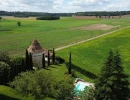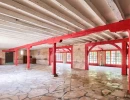



Buying a château or manor house as part of France's list of historic monuments means you can invest in a prestigious listed or listed property while benefiting from a highly attractive tax framework.
More than 45,000 buildings have been classified or listed as historic monuments since 1837. This is a public utility easement based on the heritage interest of a property, which aims to ensure its conservation, restoration and enhancement.
While you are likely to come across old buildings such as chateaux and churches, you may also come across more recent buildings designed by renowned architects, or industrial heritage such as the Batignolles factory in Nantes, which was listed as a historic monument on 3 August 2022. This system can also apply to undeveloped land (gardens, caves, parks, archaeological remains, etc.) or movable objects (furniture, jewellery, organs, etc.).
There are 2 levels of protection for historic monuments:
Classification as a Historic Monument (MH): This is the highest level of protection. A listed building is protected by the Ministry of Culture for its national importance.
Inclusion in the Supplementary Inventory of Historic Monuments (ISMH): this is the 1st level of protection, managed by the regions as part of the building's local or regional influence.
This level of protection is backed up by rigorous legislation, requiring lengthy procedures for carrying out works, for example.
Buying a historic monument is a complex and exciting undertaking. Historic monuments that have survived the centuries bear witness to the history and culture of our country. They are often situated in magnificent locations, offering breathtaking views of the surrounding countryside.
If you're looking for a historic monument to buy, you'll find châteaux, houses, keeps, outbuildings, flats and old buildings all over France on ma-propriete-prestige.fr. Outside Paris, you can find historic monuments in towns and villages in the Loire, north, south and centre of the country.
You can find properties with magnificent views, courtyards, outbuildings, farmland and old flats with lots of character. It is important to consider the environment and location of the historic monument you wish to buy, as this can have an impact on the value of the property and your quality of life.
Selling a listed site is not something you can improvise. The first thing to think about is the valuation of your property. We advise you to work with a firm specialising in this type of prestigious property, which will be able to guide you through this stage. In particular, they will take into account sales of similar properties and any work that needs to be carried out.
Selecting the right buyers is another reason to work with a property professional. An agency will be able to make an initial selection of candidates before considering a visit, based on the seriousness of their project and their financial capacity. This is an essential way of avoiding the curious. Once again, an agency specialising in prestige homes will enable you to benefit from an existing file of buyers for this type of exceptional property.
Another important point is to check that the sale is feasible. When you benefit from the tax exemption scheme, you make a commitment to hold the property for a minimum of 15 years. If you sell before this deadline, the tax advantage will be withdrawn, except in special cases such as redundancy, disability or the death of the owner or their spouse.
The owner of a listed building benefits from the following advantages:
Subsidies of up to 40% of the total cost of maintenance, repair or restoration work on listed buildings (ISMH) and up to 100% of the total cost of work on listed buildings (MH) are available.
Restoring this type of building will allow you to benefit from financial aid while restoring the character of a beautiful old house. However, you will need to work with a number of different people: the local council, the Ministry of Culture, the Regional Department of Cultural Affairs (DRAC), etc., and use approved contractors.
You may also be eligible for assistance from other bodies, notably the Fondation du Patrimoine.
The tax system also has some very important special features: expenses relating to the property are deductible up to 50% of taxable income, and even 100% when the monument is open to the public.
These benefits are, of course, subject to a minimum conservation period of 15 years. Historic monuments may also qualify for exemption from inheritance or gift tax, subject to certain conditions.
The Loi Malraux (named after the writer and former Minister of Culture who introduced it in 1962) is different from the law governing Historic Monuments. It does, however, offer an equally advantageous tax regime for restoration work carried out on buildings with character and intended for rental.
The tax reduction is :
These areas are often located in town centres or close to the town centre.
The amount of work involved is capped at €100,000 per year over 4 consecutive years, giving a tax reduction of up to €22,000 or €30,000 per year. This scheme is therefore reserved for very high taxpayers.